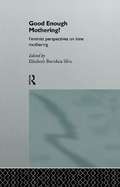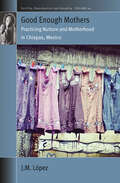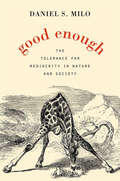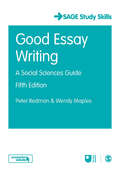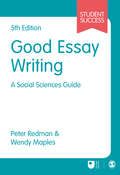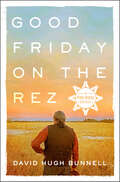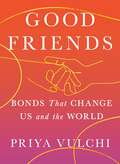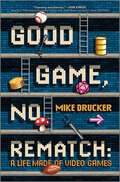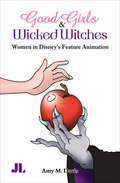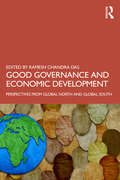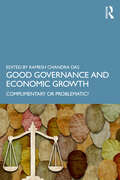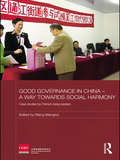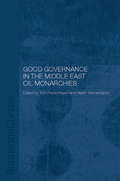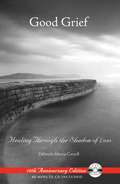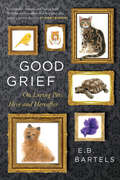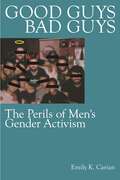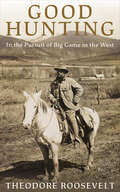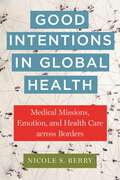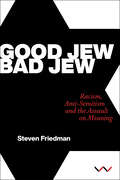- Table View
- List View
Good Enough Mothering?: Feminist Perspectives on Lone Motherhood
by Elizabeth Bortolaia SilvaCurrently, lone mothers and their children make up almost 20 per cent of families with dependent children in the UK, a threefold increase since 1970. Yet, while they are often cited by politicians as both a symptom and cause of social breakdown, relatively little is known of the causes, consequences and conditions of lone motherhood in Britain and throughout Europe. Good Enough Mothering? provides accounts of historical patterns of mothering and ideologies of the family with cross-national comparisons of policies and experience of lone motherhood in developed and developing countries. Countries include: Britain, US, Norway, South Africa, Kenya, Thailand, India, Brazil and the Caribbean. This engaging edited collection will appeal to students of social policy, women's studies and social work.
Good Enough Mothers: Practicing Nurture and Motherhood in Chiapas, Mexico (Fertility, Reproduction and Sexuality: Social and Cultural Perspectives #49)
by Jm LópezMotherhood in Mexico is profoundly shaped by the legacy of colonialism. This ethnography situates motherhood in a critical global health analysis of maternal health inequalities and interventions in the southeast state of Chiapas. Using a transitional life course framework, it demonstrates how the transition to motherhood is never complete. Once a good mother is defined, she becomes undefined, the goal posts moved, and the rules confronted.
Good Enough: The Tolerance for Mediocrity in Nature and Society
by Daniel S. MiloPhilosopher Daniel Milo offers a vigorous critique of the quasi-monopoly that Darwin’s natural selection has on our idea of the natural world. In popular thought, Darwinism has even acquired the trappings of an ethical system, focused on optimization, competition, and innovation. Yet in nature, imperfect creatures often have the evolutionary edge.
Good Essay Writing: A Social Sciences Guide (SAGE Study Skills Series)
by Peter Redman Wendy MaplesLecturers, request your electronic inspection copy here. Writing good essays is one of the most challenging aspects of studying in the social sciences. This simple guide provides you with proven approaches and techniques to help turn you into a well-oiled, essay writing machine. Good Essay Writing demonstrates how to think critically and formulate your argument as well as offering water-tight structuring tips, referencing advice and a word on those all too familiar common worries – all brought to life through real student examples from a range of subjects. Now in its fifth edition, this fresh update contains: New essay examples are analysed and discussed, so you have a clear understanding of what makes a good essay A new chapter on essay writing skills and other forms of social science writing, helping you transfer the skills you learn to different types of written assessments A new Companion Website providing additional exercises and examples, helping you practice and apply the skills. This practical guide is an absolute must for everybody wanting – or needing – to brush up on their essay writing skills and boost their grades. SAGE Study Skills are essential study guides for students of all levels. From how to write great essays and succeeding at university, to writing your undergraduate dissertation and doing postgraduate research, SAGE Study Skills help you get the best from your time at university. Visit the SAGE Study Skills hub for tips, resources and videos on study success!
Good Essay Writing: A Social Sciences Guide (Student Success)
by Peter Redman Wendy MaplesWriting good essays is one of the most challenging aspects of studying in the social sciences. This simple guide provides you with proven approaches and techniques to help turn you into a well-oiled, essay writing machine. Good Essay Writing demonstrates how to think critically and formulate your argument as well as offering water-tight structuring tips, referencing advice and a word on those all too familiar common worries – all brought to life through real student examples from a range of subjects. Now in its fifth edition, this fresh update contains: New essay examples are analysed and discussed, so you have a clear understanding of what makes a good essay A new chapter on essay writing skills and other forms of social science writing, helping you transfer the skills you learn to different types of written assessments A new Companion Website providing additional exercises and examples, helping you practice and apply the skills. This practical guide is an absolute must for everybody wanting – or needing – to brush up on their essay writing skills and boost their grades. The Student Success series are essential guides for students of all levels. From how to think critically and write great essays to planning your dream career, the Student Success series helps you study smarter and get the best from your time at university. Visit the SAGE Study Skills hub for tips and resources for study success!
Good Friday on the Rez: A Pine Ridge Odyssey (Pine Ridge Odyssey)
by David Hugh BunnellGood Friday on the Rez follows the author on a one-day, 280-mile round-trip from his boyhood Nebraska hometown of Alliance to the Pine Ridge Indian Reservation in South Dakota, where he reconnects with his longtime friend and blood brother, Vernell White Thunder. In a compelling mix of personal memoir and recent American Indian history, David Hugh Bunnell debunks the prevalent myth that all is hopeless for these descendants of Crazy Horse, Red Cloud, and Sitting Bull and shows how the Lakota people have recovered their pride and dignity and why they will ultimately triumph.What makes this narrative special is Bunnell's own personal experience of close to forty years of friendships and connections on the Rez, as well as his firsthand exposure to some of the historic events. When he lived on Pine Ridge at the same time of the American Indian Movement's seventy-one-day siege at Wounded Knee in 1973, he met Russell Means and got a glimpse behind the barricades. Bunnell has also seen the more recent cultural resurgence firsthand, attending powwows and celebrations, and even getting into the business of raising a herd of bison.Substantive and raw, Good Friday on the Rez is for readers who care about the historical struggles and the ongoing plight of Native Americans, and in particular, that of the Lakota Sioux, who defeated the U.S. Army twice, and whose leaders have become recognized as among America's greatest historical figures.Good Friday on the Rez is a dramatic page-turner, an incredible true story that tracks the torment and miraculous resurrection of Native American pride, spirituality, and culture—how things got to be the way they are, where they are going, and why we should care.
Good Friends: Bonds That Change Us and the World
by Priya VulchiFrom the co-author of Tell Me Who You Are and a TED speaker, a book that reveals the importance of friendship as a tool of social justice. Friendship is good for your health. Studies show that loneliness is as deadly as smoking fifteen cigarettes a day. Still, we are not taught how to be good friends to one another. We cancel plans, lose touch, blame technology, and neglect our non-romantic loved ones. In Good Friends, author Priya Vulchi explores friendships across history, continents, and identities to show how friendship can open up new levels of joy and community in your life. What is the meaning of friendship, these miraculous bonds with once-strangers? How do you begin friendships? End them? Keep them vibrant? For answers, Vulchi weaves through Western classical thinkers like Plato, Aristotle, and Cicero, and uncovers the private moments between good friends like James Baldwin, Dr. Martin Luther King, Jr., Yuri Kochiyama, Toni Morrison, and June Jordan. Friendship, she shows, has ripple effects beyond just any two friends; it awakens solidarity and changes in the world. Through her inspiring and impassioned prose, Vulchi entirely reimagines our platonic ties, revealing that friendship, in the right hands, is a brilliant act of love and resistance. Intimate and engaging, Good Friends offers a resounding cry that friendship is not only vital for our own individual well-being, but for humanity itself. It invites you to be inspired not just by what people do but how people love. It invites you to look at your friends differently and enter a dazzlingly fresh philosophy of human connection.
Good Game, No Rematch: A Life Made of Video Games
by Mike Drucker"Funny, genuine and knowledgeable about something that meant so much to all of us." —Ben Schwartz A hilarious and nostalgic memoir about the video games that entertain and inspire us, and even hold the power to transform our lives, from an Emmy®-nominated television writer, stand-up comedian and former writer for Nintendo.At the ripe age of three, Mike Drucker got his very first Nintendo console—the Nintendo Entertainment System—and he was hooked. Every video game felt like a new chapter was opening in his life, expanding his world for the better and—sometimes—for worse. Final Fantasy VII, for example, helped him navigate the pitfalls of an early crush. And Dance Dance Revolution taught him how to almost, kinda move his body appropriately to music. Mike split his career between gaming and comedy, landing an internship with Saturday Night Live, playing Wii Sports with the cast and crew, and then a job at Nintendo, where he named an iconic character in the Legend of Zelda series. Then he returned to comedy with a job writing for The Tonight Show, never forgetting the video games that brought him there.In this fond and joyful memoir, Drucker combines ridiculous personal stories and fascinating gaming history to explore the poignant ways that electronic entertainment can save us from ourselves. Good Game, No Rematch is a love letter to video games and the people who play them, from a very nerdy voice in the world of comedy.
Good Girls Gossip: Find Your Female Power
by Tova LeighThe ultimate guide to female friendship, mutual empowerment, and reclaiming &“gossip&” from the patriarchy, with humorous anecdotes and 30 practical exercises from social media star Tova Leigh.When women talk together, amazing things happen ...&“Some call it friendship, others call it a bunch of crazy women having a laugh ... I call it female empowerment.&”As Tova Leigh grew up, she watched how her mother and her friends gave each other permission to be who they truly were: badasses, fierce, larger than life, brave, vulnerable, compassionate, rude, outrageous, ridiculous, thoughtful ... human! The whole freaking shabbang. This was a life-changing lesson in empowerment.This book celebrates the tradition of female camaraderie, of sisterhood shared across the generations, and the communication – dismissed by the patriarchy as &“gossip&” – that binds women together.Sharing stories of inspiring women she&’s met, as well as her own experiences and practical tools to find your own power, Tova encourages us to be more curious about the women in our lives and to seek out more female friendships and mentors. Because when women come together, incredible things happen.
Good Girls and Wicked Witches: Women in Disney's Feature Animation
by Amy M. DavisIn Good Girls and Wicked Witches, Amy M. Davis re-examines the notion that Disney heroines are rewarded for passivity. Davis proceeds from the assumption that, in their representations of femininity, Disney films both reflected and helped shape the attitudes of the wider society, both at the time of their first release and subsequently. Analyzing the construction of (mainly human) female characters in the animated films of the Walt Disney Studio between 1937 and 2001, she attempts to establish the extent to which these characterizations were shaped by wider popular stereotypes. Davis argues that it is within the most constructed of all moving images of the female form--the heroine of the animated film--that the most telling aspects of Woman as the subject of Hollywood iconography and cultural ideas of American womanhood are to be found.
Good Girls, Good Food, Good Fun
by Meghan K. WinchellThroughout World War II, when Saturday nights came around, servicemen and hostesses happily forgot the war for a little while as they danced together in USO clubs, which served as havens of stability in a time of social, moral, and geographic upheaval. Meghan Winchell demonstrates that in addition to boosting soldier morale, the USO acted as an architect of the gender roles and sexual codes that shaped the "greatest generation."Combining archival research with extensive firsthand accounts from among the hundreds of thousands of female USO volunteers, Winchell shows how the organization both reflected and shaped 1940s American society at large. The USO had hoped that respectable feminine companionship would limit venereal disease rates in the military. To that end, Winchell explains, USO recruitment practices characterized white middle-class women as sexually respectable, thus implying that the sexual behavior of working-class women and women of color was suspicious. In response, women of color sought to redefine the USO's definition of beauty and respectability, challenging the USO's vision of a home front that was free of racial, gender, and sexual conflict.Despite clashes over class and racial ideologies of sex and respectability, Winchell finds that most hostesses benefited from the USO's chaste image. In exploring the USO's treatment of female volunteers, Winchell not only brings the hostesses' stories to light but also supplies a crucial missing piece for understanding the complex ways in which the war both destabilized and restored certain versions of social order.
Good Governance
by N Bhaskara RaoBased on the findings of large-scale field surveys, Good Governance provides a primary review of trends in corruption, as encountered by citizens when availing of public services, and offers insightful suggestions on ways to implement good governance. Given the adverse effects of corruption on society, economy, citizenship and civic life, the author illuminates upon a comprehensive understanding of the linkages involved in corruption processes and operations, and provides a strategic approach to curb this menace together with a methodology for ensuring graft-free delivery of public services. Not delineating corruption from the fabric of daily life, the discussion centres around a broad framework on how to go about addressing corruption from different perspectives-how the government should tackle it, what initiatives citizens and civil society should take and how the news media could explore a proactive and contributing role. In fact, the book says that the media is capable of covering corruption with a direct objective of curbing it. Thus, the fight against corruption has to be strategic, focused and multipronged. Good Governance talks about the pertinent problem of creating sustained public pressure for change, the emphasis being on the proactive need for change.
Good Governance and Economic Development: Perspectives from Global North and Global South
by Ramesh Chandra DasGood governance is a prerequisite to development, improving the quality of life, and health and ensuring equity. This book examines the interdependency of good governance and economic development by exploring perspectives from the Global North and the Global South.It assesses the impact of good governance on economic development of countries such as the USA, India, Nigeria, Turkey, Pakistan, Bangladesh, Nepal and others, and on groups of developing nations like BRICS or ASEAN. The book investigates the interrelationships between development indicators like education, health, gender equity, resource distribution, environmental preservation, quality of life, livelihood and others with governance and provides empirical verifications of the impact of good governance upon development. Further, it offers insights into the economic and governance challenges that developing countries face and highlights strategies for governance that have proved effective in bolstering sustainable growth.This volume will be of interest to students and researchers of economics, political science, social science, international relations, public administration and sociology.
Good Governance and Economic Growth: Complimentary or Problematic?
by Ramesh Chandra DasGovernance has been incorporated into the development models of many countries because of its role in ameliorating inequalities in society. This book explores whether good governance boosts or hinders economic growth with perspectives from countries like India, the USA, Nigeria, Turkey, Pakistan, Bangladesh, Nepal, and others, and on groups of developing nations like BRICS and ASEAN.Governance has twin roles within economic systems. The first is where it guides administrators and the second is the normative role where it may act as a stimulus to economic growth and development. With the help of empirical investigations, this book analyses the interrelationships between good governance and inclusive and sustainable economic growth, productive employment, political stability, and decent work for all. It assesses the impact of various governance indicators and policy strategies on the economy and the GDP of countries in the Global North and South. The book also focuses on roadblocks to good governance such as violent conflicts, corruption, international threats and crises and its implication on economic growth. This volume will be of interest to students and researchers of economics, political science, social science, international relations, public administration, and sociology.
Good Governance in China - A Way Towards Social Harmony: Case Studies by China’s Rising Leaders (Routledge Studies on the Chinese Economy)
by Wang MengkuiGood governance is necessary for effective public administration and delivery of public goods and services. This is an important issue for all countries, but in particular for rapidly developing countries such as China where reform of governance and public administration is a key element of the public policy agenda. This book explores the key issues in governance and public administration facing China’s policy-makers today. Edited by Wang Mengkui, the former President of the Development Research Center of the State Council, and Chairman of the China Development Research Foundation - one of China’s leading think-tanks - it contains 36 papers selected from nearly 300 case studies presented by participants in the China’s Leaders in Development Executive Program. The authors are outstanding and experienced officials, and together represent the voice of China's new rising generation of leaders, policy-makers and officials. The cases are based on first-hand information and experiences either from the officials’ personal involvement, or their own in-depth investigations. The chapters cover a wide range of issue areas, such as institutional reform, urban construction, social governance, crisis management, resource and ecological environmental management, education and public health, and economic reform and development. Taken together, it provides an invaluable resource for anyone seeking to understand China’s own thinking on its governance and public administration.
Good Governance in the Middle East Oil Monarchies (Durham Modern Middle East and Islamic World Series)
by Tom Pierre Najem Martin HetheringtonThe concept of 'good governance' is of increasing importance, and is used by international organizations to ensure reasonable conformity to high standards in states which participate in the global trading regime and other international activities. This book examines the concept of good governance and how it is applied in the states of the Gulf Co-operation Council. These states are particularly important because of their strategic location and massive oil wealth. Moreover, as monarchies, in most cases without powerful democratic representative bodies, and as Islamic countries, with a different outlook from countries of the West, Western standards of good governance may need to be modified in order for them to be implemented effectively.
Good Grief: Healing Through the Shadow of Loss
by Deborah Morris CoryellA compassionate guide to the experience of loss as an essential growth process • Explores the nature of loss as a profound mystery shared by all human beings • Offers sensitive and practical advice for experiencing grief and preparing for the healing journey that follows We grieve only for that which we have loved, and the transient nature of life makes love and loss intimate companions. In Good Grief professional grief educator Deborah Morris Coryell describes grief as the experience of not having anywhere to place our love, of losing a connection, an outlet for our emotion. To heal grief we have to learn how to continue to love in the face of loss. In this compassionate guide, Coryell gives inspiring examples of how embracing our losses allows us to awaken our most profound connections to other people. Though our society tends to rank losses in a “hierarchy of grief,” she reminds us that all losses must be grieved in their own right and on their own terms, and that we must honor the “small” losses as well as the “big” ones. Paying attention to even the most minute experiences of loss can help us to be more in tune with our responses to the greater ones, allowing us to once again become part of the rhythm of life from which we have become disconnected.
Good Grief: On Loving Pets, Here and Hereafter
by E.B. BartelsAn unexpected, poignant, and personal account of loving and losing pets, exploring the singular bonds we have with our companion animals, and how to grieve them once they’ve passed.E.B. Bartels has had a lot of pets—dogs, birds, fish, tortoises. As varied a bunch as they are, they’ve taught her one universal truth: to own a pet is to love a pet, and to own a pet is also—with rare exception—to lose that pet in time.But while we have codified traditions to mark the passing of our fellow humans, most cultures don’t have the same for pets. Bartels takes us from Massachusetts to Japan, from ancient Egypt to the modern era, in search of the good pet death. We meet veterinarians, archaeologists, ministers, and more, offering an idiosyncratic, inspiring array of rituals—from the traditional (scattering ashes, commissioning a portrait), to the grand (funereal processions, mausoleums), to the unexpected (taxidermy, cloning). The central lesson: there is no best practice when it comes to mourning your pet, except to care for them in death as you did in life, and find the space to participate in their end as fully as you can.Punctuated by wry, bighearted accounts of Bartels’s own pets and their deaths, Good Grief is a cathartic companion through loving and losing our animal family.
Good Guys, Bad Guys: The Perils of Men's Gender Activism
by Emily K. CarianExplores questions of masculinity, privilege, and identity to explain why some men become feminists while others become men’s rights activistsIn the evolving landscape of gender activism in the United States, it is intriguing that four-in-ten American men now identify as feminists. Despite this seemingly positive shift, gender inequality remains deeply rooted in the US. Good Guys, Bad Guys delves into this paradox, unraveling the complexities of men’s feminist allyship and its limitations in propelling genuine progress.Emily K. Carian masterfully dissects the narratives of two distinct groups of gender activists: feminist men and men who belong to the men's rights movement, which opposes feminism. By engaging directly with the men themselves, Carian constructs a compelling analysis of their journeys into these contrasting social movements.Surprisingly, Carian finds that both feminist men and men’s rights activists share a common motivation for their engagement in gender activism: the desire to be perceived as “good men.” However, this well-intentioned yet superficial drive hinders feminist men from envisioning concrete and effective strategies to challenge gender inequality. Conversely, it fuels men’s rights activists’ participation in a movement that fosters a virulent misogyny.Good Guys, Bad Guys exposes how even self-proclaimed feminist men inadvertently perpetuate gender inequality through their attitudes, behaviors, and relationships. As society navigates the complexities of gender activism, this book serves as a valuable resource in guiding the path towards a truly equal and inclusive future.
Good Hunting: In Pursuit of Big Game in the West
by Theodore RooseveltStep into the rugged wilderness of the American West with one of history's most iconic figures, Theodore Roosevelt, in his thrilling and insightful book, Good Hunting: In Pursuit of Big Game in the West. This classic work offers readers a firsthand account of Roosevelt's adventures as a hunter, conservationist, and naturalist, capturing the essence of the wild frontier and the majesty of its big game.
Good Husbandry: A Memoir
by Kristin KimballFrom the author of the beloved bestseller The Dirty Life, this &“superb memoir chronicles the evolution of a farm, marriage, family, and her own personal identity with humor, insight, and candor&” (Publishers Weekly, starred review) detailing life on Essex Farm—a 500-acre farm that produces food for a community of 250 people.The Dirty Life chronicled Kimball&’s move from New York City to 500 acres near Lake Champlain where she started a new farm with her partner, Mark. In Good Husbandry, she reveals what happened over the next five years at Essex Farm. Farming has many ups and downs, and the middle years were hard for the Kimballs. Mark got injured, the weather turned against them, and the farm faced financial pressures. Meanwhile, they had two small children to care for. How does one traverse the terrain of a maturing marriage and the transition from being a couple to being a family? How will the farm survive? What does a family need in order to be happy? Kristin chose Mark and farm life after having a good look around the world, with a fair understanding of what her choices meant. She knew she had traded the possibility of a steady paycheck, of wide open weekends and spontaneous vacations, for a life and work that was challenging but beautiful and fulfilling. So with grit and grace and a good sense of humor, she chose to dig in deeper. Featuring some of the same local characters and cherished animals first introduced in The Dirty Life, (Jet the farm dog, Delia the dairy cow, and those hardworking draft horses), plus a colorful cast of aspiring first-generation farmers who work at Essex Farm to acquire the skills they need to start sustainable farms of their own, Good Husbandry &“considers what it means to build a good, happy life, and how we are tested in that endeavor&” (Mary Beth Keane, New York Times bestselling author of Ask Again, Yes).
Good Intentions in Global Health: Medical Missions, Emotion, and Health Care across Borders (Anthropologies of American Medicine: Culture, Power, and Practice)
by Nicole S. BerryExplores informal global health action and the importance of intentions of those who volunteerIn the past two decades, medical missions have gained popularity among medical professionals, who view these excursions as important ethical interventions. Indeed, the notion of giving back by volunteering in rural or impoverished communities is celebrated as an ideal act of selflessness, one whose effects are unquestionably beneficial to those being served.Good Intentions in Global Health is a groundbreaking exploration of the growing realm of informal global health engagement, shedding light on the intricate interplay between intentions, emotions, and ethical considerations. Drawing on fieldwork in Guatemala, Nicole S. Berry investigates those who volunteer for short-term medical missions, revealing how the intent to do good shapes their everyday understandings of their own actions taken in the global health domain.Berry uncovers how the glorification of medical missions can obscure problems that stem from North American clinicians doctoring in places where they typically do not understand the context. The short-term nature of missions also means that volunteers are not privy to the long-term effects of their actions—the potential harms that may arise from a lack of sustained follow-up care or the utter absence of documentation that they were even there. By relying on gut instincts to reassure themselves that they are doing good, volunteers often bypass a comprehensive assessment of the ethical dimensions underlying their global health work.Good Intentions in Global Health shows why desires and emotions are increasingly important to contemporary global health. She makes the case that we must pay attention to volunteers’ perceptions of their work, however wrongheaded or naïve, in order to truly influence global health on the ground.
Good Is the New Cool: Market Like You Give a Damn
by Bobby Jones Afdhel Aziz"We are at a crossroads: either we can try to prop up the old, broken marketing model, or we can create a new model, one that is fit for the unique challenges of today." --From Good Is the New CoolMarketing has an image problem. Media-savvy millennials, and their younger Gen Z counterparts, no longer trust advertising, and they demand increased social responsibility from their brands--while still insisting on cutting-edge products with on-trend design. As always, brands need to be cool--but now they need to be good, too. It's a tall order, and with new technology empowering consumers to bypass advertisements altogether, it won't be long before the old, advertising-based marketing model goes the way of the major label. If only there was a new model, one that allowed companies to address environmental, civic, and economic issues in a way that grew their brand and business, while giving back to society, and re-branding branding as a powerful force for good. Enter Good is The New Cool, a bold new manifesto from marketing experts Afdhel Aziz and Bobby Jones. In provocative, whip-smart, and streetwise style, they take aim at conventional marketing, posing the questions few have had the vision and courage to ask: If the system is broken, how can we fix it? Rather than sinking money into advertising, why not create a new model, in which great marketing optimizes life? With seven revolutionary new principles--from "Treat People as Citizens, Not Consumers," to "Lead with the Cool"--and insights and interviews from a new generation of marketers, social entrepreneurs, and leaders of such brands as Zappos, Citibank, The Honest Company, as well as the culture creators working with artists like Lady Gaga, Pharrell, and Justin Bieber, this rule-breaking book is the new business model for the twenty-first century, and a call to action for anyone committed to building a better tomorrow. This visionary book won't just change your business--it will change the world.
Good Jeans: 10 Simple Truths about Feeling Great, Staying Sexy & Aging Agelessly
by Diane GilmanTen secrets that help women reinvent and reinvigorate themselves as they approach the over-40 milestone, and beyond.
Good Jew, Bad Jew: Racism, anti-Semitism and the assault on meaning
by Steven FriedmanShows how anti-Semitism has been distorted to serve the Israeli stateGood Jew, Bad Jew is a critique by one of South Africa’s foremost political theorists of mainstream understandings of Jewishness. Steven Friedman offers a searing analysis of the weaponisation of anti-Semitism in service of political objectives that support the Israeli state and global white supremacy. Looking specifically at the way in which language is used to shape identities, Friedman uses many examples to illustrate how anti-Semitism and anti-Semites are increasingly defined as anything and anyone that opposes the interests and policies of the Israeli state.The use of anti-racist language to defend racial domination distorts not only the meaning of what it is to be Jewish, but sheds light on how all dogmatic nationalisms function. Friedman uses India and South Africa as examples, but the analysis applies across the world too.Good Jew, Bad Jew does not offer a simplistic binary understanding of Jewishness and the actions of the Israeli state and ideology. It is a detailed, deeply researched and critical work that will appeal to both specialists and general readers looking for a considered view on how language shapes belief systems and how the powerful forces of racism and nationalism – and their opponents – are being misrepresented.
